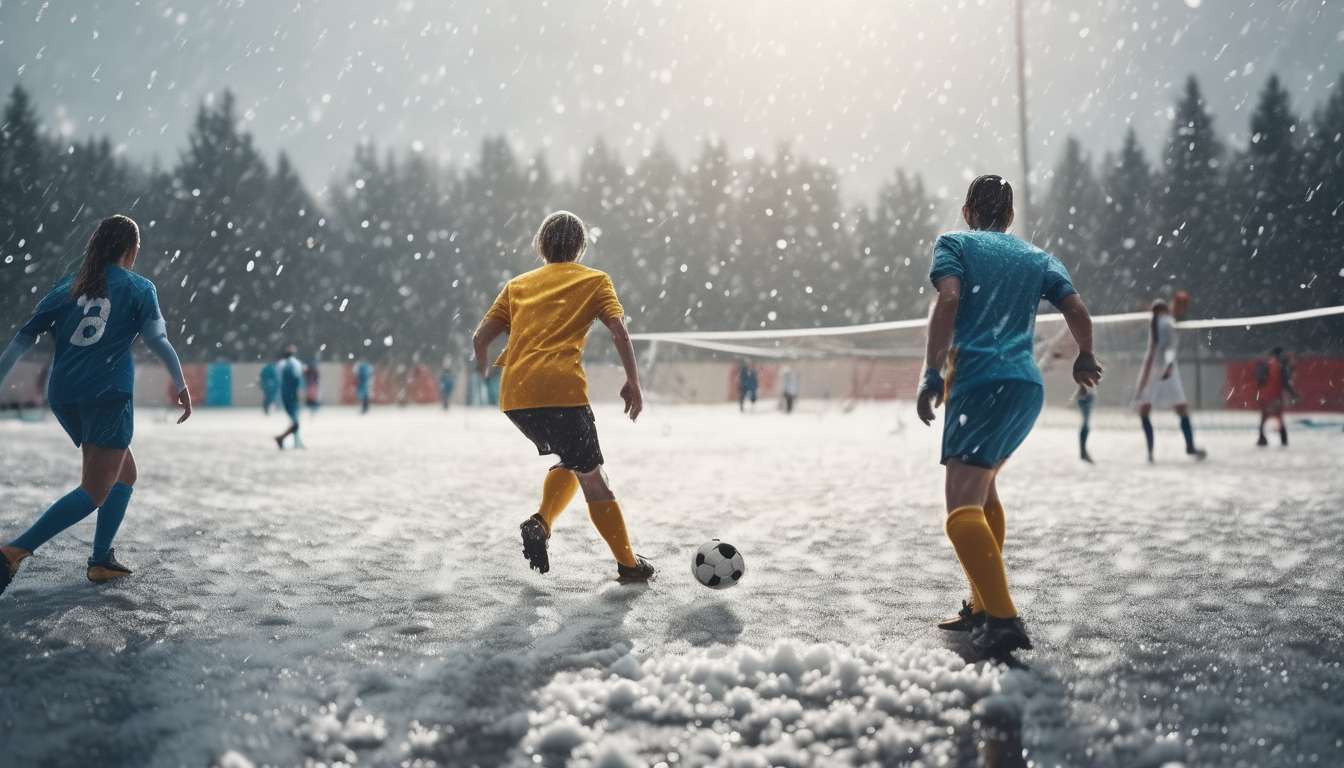As avid sports enthusiasts, we have all experienced how weather can make or break a game. Whether it’s the exhilaration of playing under clear skies or the challenges posed by an unexpected downpour, weather conditions affect not only the players but also the audience’s experience.
In this article, we explore the intricate relationship between climate and sports, delving into six key ways weather impacts the games we love.
-
Player Endurance:
- Sweltering heat can significantly influence player stamina and performance.
- Athletes may require more frequent hydration breaks and strategic play adjustments.
-
Ball Trajectories:
- Chilling winds can alter the path of a ball, affecting accuracy and game dynamics.
- Players may need to adjust their techniques to accommodate wind conditions.
-
Surface Conditions:
- Rain can lead to slippery surfaces, increasing the risk of injuries and changing gameplay.
- Teams might need to modify their footwear and tactics to maintain performance.
-
Audience Experience:
- Weather conditions can impact spectator comfort and attendance.
- Event organizers may need to provide amenities like covered seating or weather updates.
-
Game Scheduling:
- Extreme weather conditions can lead to game delays or cancellations.
- Flexibility in scheduling and preparedness for rescheduling are crucial for continuity.
-
Equipment and Gear:
- Weather-resistant equipment may be necessary to withstand adverse conditions.
- Teams often need to invest in specialized gear to ensure safety and performance.
We understand that as fans, coaches, and players, anticipating and adapting to these conditions is vital for success. Our goal is to uncover insights that will better prepare us for future games, ensuring that no matter what Mother Nature throws our way, we can continue to enjoy the thrill of sports to the fullest.
Player Endurance Impact
Extreme weather conditions significantly affect players’ endurance during games. Climate can transform a match into a test of sheer willpower, where it’s not just about skill but also about who can withstand the harsh elements. When temperatures soar or plummet, athletes’ endurance is truly challenged.
As a community of fans, we share a collective concern for our favorite players’ well-being. Scheduling becomes crucial in these climates. Organizers must consider the time of day games are played to mitigate the impact of extreme weather.
- Early morning or late evening matches can help reduce the impact of extreme heat.
- This timing gives players a better chance to catch their breath and perform at their best.
By being mindful of climate conditions, we can create a more favorable environment for athletes to thrive in. Let’s continue advocating for smart scheduling that respects both the players and the natural conditions they face.
Together, we can ensure competitive and fair games.
Ball Trajectories Altered
Extreme Weather Conditions and Ball Trajectories
Extreme weather conditions can drastically alter ball trajectories, challenging players to adjust their strategies mid-game.
- Wind gusts can redirect the ball, requiring players to predict and react swiftly.
- Humidity impacts air density, causing the ball to travel differently.
These conditions test our endurance as athletes and as fans who understand these challenges.
Community Resilience and Adaptability
When we consider how climate affects our games, we’re reminded of the shared resilience and adaptability that bind us as a community. In our tightly knit circles, we know that scheduling matches around unpredictable weather is crucial.
It’s not just about playing; it’s about thriving together even when the climate doesn’t cooperate. Whether we’re on the field or cheering from the stands, we all feel the impact of these elements.
Collective Spirit and Determination
When the climate throws us a curveball, it’s our collective spirit and determination that keep the game alive. We adapt, strategize, and continue to play the game we love, come rain or shine.
Changing Surface Conditions
Changing Surface Conditions and Adaptation
Changing surface conditions demand that we constantly adjust our play style to maintain performance and prevent injuries. As a community, we know that climate changes can turn familiar playing fields into unpredictable terrains.
- Wet surfaces might slow us down, requiring greater endurance and agility.
- On dry, hard fields, we risk more impact injuries, so we adapt our techniques to stay safe.
Community and Communication
Our shared love for the game drives us to face these challenges together. We rely on one another to communicate about changes in the field’s condition, ensuring everyone is aware and prepared.
This camaraderie strengthens our bond and enhances our collective performance.
Scheduling and Resilience
Scheduling becomes crucial when climate impacts surfaces. We often need to reschedule games or practices to times when conditions are optimal, ensuring our safety and game quality.
By doing so, we maintain our resilience and commitment to the sport we love, proving that our passion transcends any environmental hurdles.
Together, we rise to meet every challenge.
Audience Comfort Considerations
Spectators’ comfort is a priority for us, as we adjust seating arrangements and provide amenities to ensure they enjoy the game regardless of weather conditions. We understand that a welcoming atmosphere contributes to a sense of community and belonging.
In varying climates, we provide fans with essentials like:
- Sunshades
- Rain ponchos
- Heating lamps
This ensures everyone can focus on the game with ease, enhancing their overall experience.
The climate can test not just the players’ endurance but also that of our audience. We strive to create a space where fans can relax and revel in the excitement without discomfort. By offering accessible seating options and climate-appropriate amenities, we foster a sense of unity, encouraging everyone to be part of the action.
While scheduling plays a role in determining game times, our preparations guarantee that, no matter the weather, our audience feels valued and included in the shared experience of live sports.
Game Scheduling Challenges
Balancing game schedules with unpredictable weather patterns demands flexibility and strategic planning. Climate can disrupt even the best-laid plans, testing the endurance of organizers and participants alike. It’s essential not just to set a date but to anticipate the unexpected and adapt quickly.
Considerations for managing climate impact on events:
- Assess how climate shifts might affect scheduled events.
- Be prepared to pivot at a moment’s notice.
Community connection is crucial, and scheduling plays a vital role in fostering this unity. When unpredictable weather threatens to disrupt gatherings, it’s important to:
- Lean on each other.
- Share insights and experiences.
- Find creative solutions, such as rescheduling games or locating indoor alternatives.
By embracing a flexible approach and prioritizing communication, we can navigate scheduling challenges effectively. This ensures our passion for the game endures, despite the unpredictable climate, and fosters a strong sense of unity and belonging within the community.
Necessity of Weather-Resistant Gear
We must equip ourselves with weather-resistant gear to ensure that games continue safely and comfortably, no matter the conditions. As teammates, we understand that the climate can be unpredictable, and its challenges test our endurance. Whether it’s rain-soaked fields or icy winds, the right gear helps us stay focused and perform at our best. Together, we adapt and overcome, united by our shared commitment to the game and each other.
Our choice of gear directly impacts how we handle the elements. Essential items include:
- Waterproof jackets
- Thermal layers
- Moisture-wicking fabrics
These become our armor against nature’s tests. They allow us to maintain our energy and concentration, no matter what the climate throws at us. When our gear works with us, it fortifies our resolve and enhances our endurance.
Moreover, weather-resistant gear influences scheduling decisions. With the right protection, we can reduce delays and cancellations, ensuring that our games proceed as planned. By preparing together, we strengthen our bond and face every challenge head-on.
Impact on Spectator Attendance
Spectator attendance can significantly decline when adverse weather conditions make outdoor events uncomfortable or unsafe.
The climate doesn’t just test the endurance of athletes but also challenges us, the fans, who brave the elements to support our teams. When the sky threatens to unleash a storm or temperatures plummet, our collective enthusiasm can wane. We find ourselves weighing the joy of cheering in person against the discomfort and potential hazards.
Smart scheduling becomes crucial in these situations.
- Events are often rescheduled to avoid the worst of the weather, aiming to maintain that sense of community we cherish.
- Games held during milder conditions ensure we can come together without enduring extreme climates.
It’s not just about the game; it’s about belonging to something greater, sharing the highs and lows with fellow fans.
Let’s advocate for better planning and support systems, ensuring our shared passion remains vibrant, regardless of the climate’s unpredictability.
Adaptation for Optimal Performance
Athletes and teams are continually refining their strategies and training regimens to thrive regardless of unpredictable weather conditions. Embracing the climate’s challenges can foster a sense of unity and resilience. By incorporating climate-specific training, athletes bolster their endurance and enhance their ability to perform optimally.
Adaptation to Weather Conditions:
-
Whether it’s scorching heat or biting cold, athletes adapt their routines to ensure readiness for any conditions.
-
Incorporating climate into scheduling allows practice sessions to mirror potential game-day conditions.
-
Training at different times of the day exposes athletes to varying temperatures and humidity levels, boosting overall endurance.
Benefits of Climate-Specific Training:
-
Mental and Physical Toughness: An adaptive approach helps build both mental and physical resilience, ensuring athletes are not caught off guard by sudden changes in weather.
-
Community Bonding: Sharing climate adaptation experiences strengthens community bonds. Celebrating resilience and determination brings athletes closer together.
Conclusion:
Let’s continue to adapt and excel, supporting one another through every weather-induced hurdle. Each challenge conquered enhances our unity and strengthens our commitment to thriving in any environment.
How do professional sports leagues prepare for unexpected weather disruptions during games?
We always make sure to have a solid plan in place for unexpected weather disruptions during games.
Our team closely monitors weather forecasts and prepares accordingly. This may involve several strategies:
- Alternative game schedules
- Indoor facilities on standby
- Communication strategies with fans
Safety of players and spectators is our top priority, so we stay proactive and flexible to handle any weather challenges that may arise.
What role does climate play in the economic aspects of hosting outdoor sporting events?
Climate’s Economic Impact on Outdoor Sporting Events
Climate significantly influences the economics of hosting outdoor sporting events. It affects various financial aspects, such as:
- Ticket sales
- Merchandise revenue
- Overall attendance
Weather-Related Challenges
Unfavorable weather conditions can lead to:
- Game cancellations or rescheduling, impacting budgets for both fans and organizers.
- The necessity for additional investments in infrastructure or equipment to ensure attendee safety and comfort during extreme temperatures or storms.
These factors collectively shape the financial implications of hosting outdoor events.
How have historical weather events influenced the rules and regulations of outdoor sports?
Historical weather events have significantly shaped the rules and regulations of outdoor sports.
From intense heatwaves to unexpected downpours, these conditions have forced governing bodies to implement safety measures and adapt gameplay.
For example:
- Extreme heat may lead to hydration breaks in soccer matches.
- Heavy rain can result in the suspension of play in tennis tournaments.
Overall, these adjustments ensure the well-being of athletes and maintain the integrity of the sport.
Conclusion
In conclusion, weather plays a crucial role in shaping the dynamics of sports and games. Its impact is undeniable, affecting various aspects of both player performance and the overall game experience.
Weather influences sports in several ways:
-
Player Endurance: Adverse weather conditions can challenge athletes’ stamina and physical endurance.
-
Ball Trajectories: Wind and rain can alter the movement of balls, affecting the outcome of games.
-
Audience Comfort: The comfort of spectators is also influenced by weather, which can affect attendance and engagement.
To ensure optimal performance and enjoyment, it is essential to consider:
-
Game Scheduling: Organizing events during favorable weather conditions can enhance both player performance and audience experience.
-
Weather-Resistant Gear: Utilizing appropriate gear can help athletes perform better in challenging conditions.
Adapting to changing weather conditions is key for both players and spectators alike to maximize enjoyment and success in sports. By anticipating and preparing for weather variations, everyone involved can contribute to a seamless and enjoyable sporting experience.




